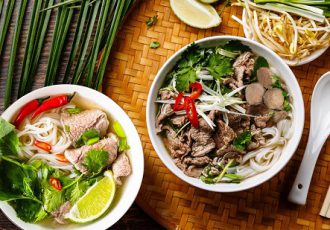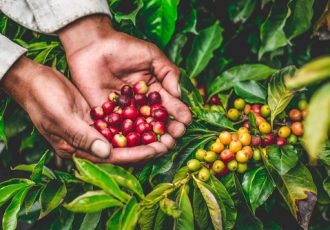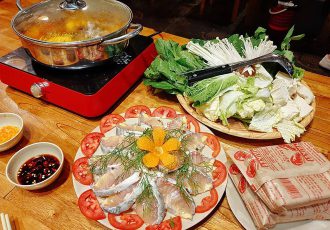Vietnamese food is very varied and refined, they are marked by the diversity of ingredients and aromatic herbs such as coriander or lemongrass often used in the dishes.
Rice is the essential ingredient in Vietnamese dishes and is the staple food of its inhabitants from North to South. Rice is present at the table from morning to evening, from January to December, in the countryside as well as in the city. A peasant family’s meal usually consists of three dishes: rice, vegetables and a little meat or fish. Good rice is a precious gift that country people give to their relatives and friends in the city when they visit them and at important times of the year. It is said that in Vietnam, a long day is like a day without rice.
There are many Vietnamese expressions related to rice…
“He doesn’t want rice anymore, he wants to taste the earth”, to say, in a figurative way, that someone is dying or very sick, reveals the importance of rice in the Vietnamese culture.
Vietnamese also often use the expression, to talk about an unfaithful husband dreaming of another woman than his companion: “he is tired of rice, he wants to taste Chinese soup”.
A happy man is compared to “a rat in a pot of rice”…
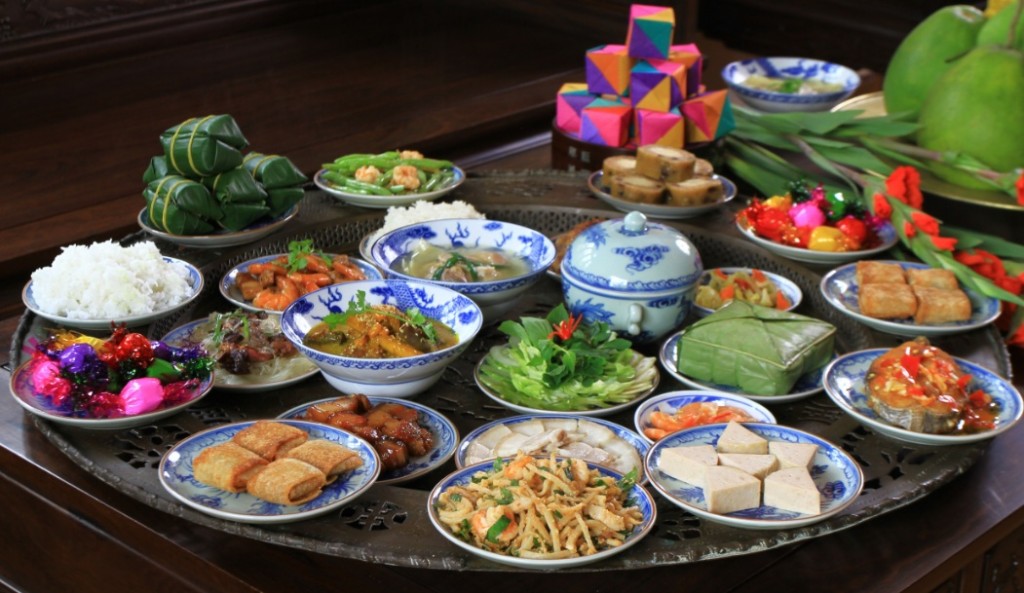
an com means in Vietnamese to have a main meal made of rice and accompanied by several dishes.
The rice is cooked by putting it in boiling water. When there is no more water, it is left to simmer. An ordinary meal (also called a folk meal) consists of rice and food. In our modern life, the automatic “rice cooker” is now very often used.
Of course, Vietnamese cuisine is a skilful art of using this rice daily to make each day a renewed and delicious eating pleasure.
For this reason, the dishes that accompany the rice are generally meat, fish, shrimp, tofu, stir-fried vegetables, salted vegetables…
Many types of soups also accompany the traditional meal: soup (meat, vegetables, ribs…), crab soup, fish soup…
Nom (chopped vegetable salad) is also a famous starter in Vietnamese cuisine. It is made of very finely chopped green papaya, cucumber, carrot, boiled lean pork, seasoned with crushed peanut, vinegar, sugar, garlic, chilli. The name thus has various tastes. It is used in both daily meals and banquets.
In recent years, Vietnamese people have become accustomed to eating lunch at their workplaces. Popular restaurants are springing up everywhere, especially near public services.

Rice or rice noodles are the basis of all Vietnamese dishes
Fish, chicken and pork dishes, accompanied by cooked vegetables and steamed rice, make up the traditional meals. Vietnamese dishes themselves are not usually spicy, however you will always find a wide variety of condiments on your table including chilli sauce, soy sauce and the famous Nuoc Nam fish sauce.
Rice powder is used as an ingredient in a large number of dishes (nem, ravioli, pancakes, Tonkin soup, vermicelli, rice cakes, etc.). Rice can be wholemeal, round, long, crushed, perfumed, sticky, etc. It can come from the delta or the mountains, from the summer or winter crops. It can be old (harvested the previous year) or new.
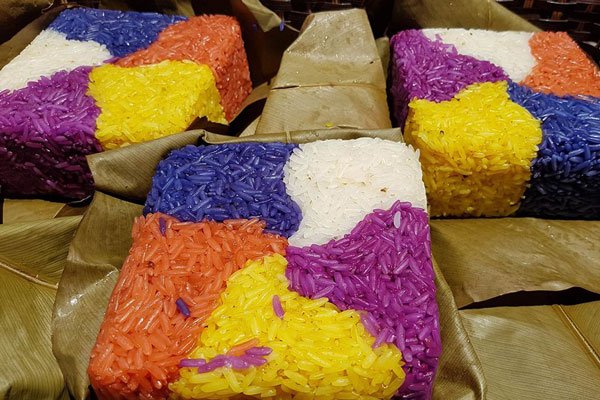
Mixed sticky rice – one of the most typical Vietnamese dishes
Vegetables
When talking about Vietnamese dishes, one has to mention vegetables, the most famous preparations with vegetables are: boiled vegetables, fermented vegetables, vegetables sautéed in oil and chopped vegetable salads.
Among the vegetables, green papaya, water bindweed and aubergine are so common that they have been included in the literature.
Those who watched the film “The Smell of the Green Papaya” by the French director of Vietnamese origin Tran Anh Hung, may remember this modest plant hiding behind houses, offering fruits that, when green, are eaten like vegetables and, when ripe, like real fruits. It is said that the green papaya is the symbol of Vietnamese women, shy but enterprising.
But when it comes to symbols, the freshwater bindweed also has something to say – it represents both :
Modesty (it grows on the surface of ponds and rivers or small streams), vitality (just throw a stem into the water and you will have a whole pond of water bindweed three months later)
Beauty (its fine flowers, purple or white depending on their variety, have an undeniable power of seduction)
Wealth (the peasant’s dream of abundance was summed up in this proverb: A pool of water bindweed and a jar full of soy sauce).
Often seen as the main dish of the poor, water bindweed is nevertheless a popular part of daily meals in the city. Once boiled, it is eaten with fish sauce (nuoc mam) or soy sauce. Its broth, spiced with lemon, green mango or pancake fruit, gives it all its thirst-quenching power in summer. Stir-fried with beef or buffalo meat, it becomes the dish for celebrations.
Eggplants fermented in an earthenware jar are used as a preserving agent for a season or even for the whole year. There are several types of eggplants: bowl-shaped eggplants, firecracker eggplants (which burst when bitten), purple eggplants or Hue eggplants, goat’s yard eggplants, etc. The fermented eggplant is a faithful friend in times of need.
A proverb reminds us of this: “The aubergine rots in the corner of the pantry. Let a misfortune occur and it will be remembered”.
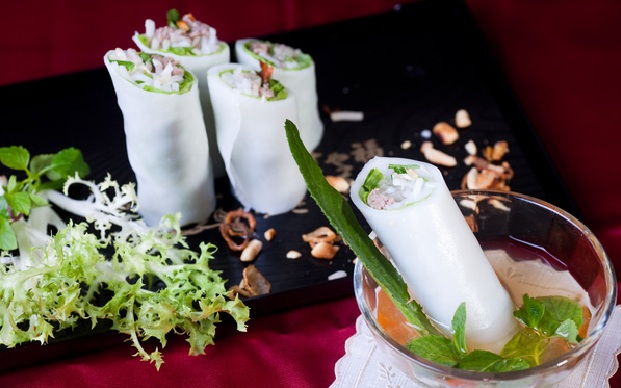
Pho Cuon – top 10 best Vietnamese dishes
Practically all Vietnamese dishes are the product of a combination of several vegetables, or vegetables and spices, fish and shellfish… Vietnamese dishes, whether sautéed, boiled, simmered, stewed, boiled in a bain-marie, or in salads, are always made up of meat, fish, vegetables, fruit, roots and other seeds. Meat alone is rarely found, and there is a funny saying “nau canh suong, o truong ma nau” (a soup with nothing on it, you might as well go for a walk naked).
Traditional dishes are also the result of combinations of several ingredients. Banh Chung (Tet cake) is made of glutinous rice, mung beans, pork, bacon, shallots, and even maranta leaves, which are used to wrap the cake and give it a pleasant aroma.
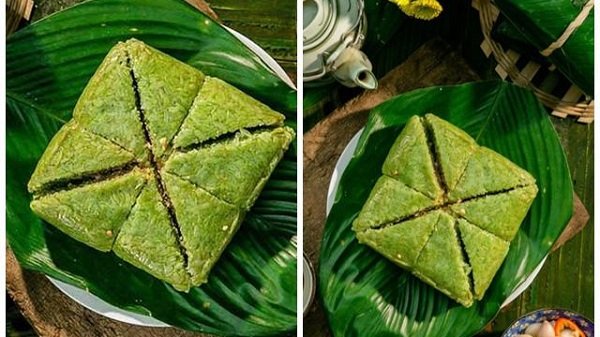
Banh Chung – one of the essential Vietnamese dishes during Tet
The Vietnamese meal is also a process of combining different dishes. When eating, there are always several dishes on the tray: rice, soup, salad, pickled vegetables, fish, meat, either sautéed, simmered, boiled or caramelised. Each bowl of rice is the result of a marriage. In one bite, there can be rice, soup, vegetables, meat, all together.
Here are some examples of famous dishes:
Thit kho tau (caramel pork) is prepared with pork cut into large pieces and boiled with duck eggs and Siamese coconut milk.
Cha Ca (fried fish with turmeric and dill): Ce plat constitue une des plus fameuses spécialités du Nord. Il s’agit de filets de poisson frit, poisson que l’on ne trouve que dans les environs de Hanoi, servi avec des vermicelles de riz, des cacahuètes grillées et des herbes aromatiques.
Pho (noodle soup): This noodle soup is one of the most popular Vietnamese dishes and is usually eaten for breakfast. It consists of a clear broth with ginger, minced beef or chicken, herbs, coriander, star anise, cloves and rice noodles. This mixture of liquid and solid makes a light and consistent dish.
Bun Cha (rice noodles and grilled pork): Bun means rice vermicelli. These vermicellies are made from rice flour and are prepared in many ways. The ingredients of this dish are simple, but when combined, they are a delight to the palate. The dish is made up of rice noodles, small pieces of grilled pork, and fresh herbs, all mixed in a broth with lots of fish sauce and garlic. This dish is usually accompanied by some egg rolls or spring rolls.
Bun oc (rice noodles and snails): This is another variation of noodle dishes. The freshwater snails used for this dish will have been soaked for 10 hours in fresh water and then boiled before being removed from their shells and added to a broth made with tomatoes, vinegar and fragrant herbs.
Mien (rice and cassava vermicelli): These noodles are made from a mixture of rice and cassava flour. Like rice or bun, Mien is the basis of many Vietnamese dishes and is usually served fried with chicken (Ga) or crab (Cua).
Cao Lau: Cao Lau is another noodle dish, this time from the Hoi An and Danang region. The thick noodles in this dish are made from rice flour. They are soaked in cloudy water from a single spring in the region and cooked 3 times. These noodles are then mixed with fine pieces of roasted meat, bean sprouts, pork and fragrant herbs.
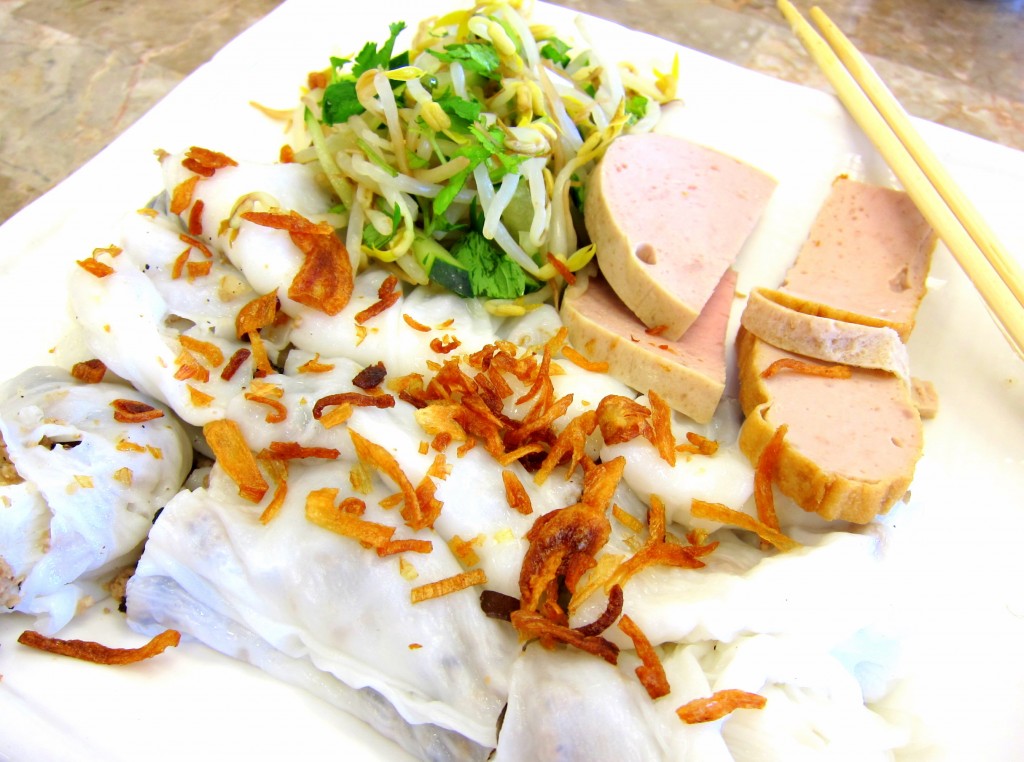
Rice cakes, also in the top 10 Vietnamese dishes
Nem Ran ou Cha Gio (spring roll or egg roll): This specialty is found from the north to the south of the country. It is a cylinder-shaped rice pancake containing small vermicelli, crab, pork, onions, herbs and sea mushrooms.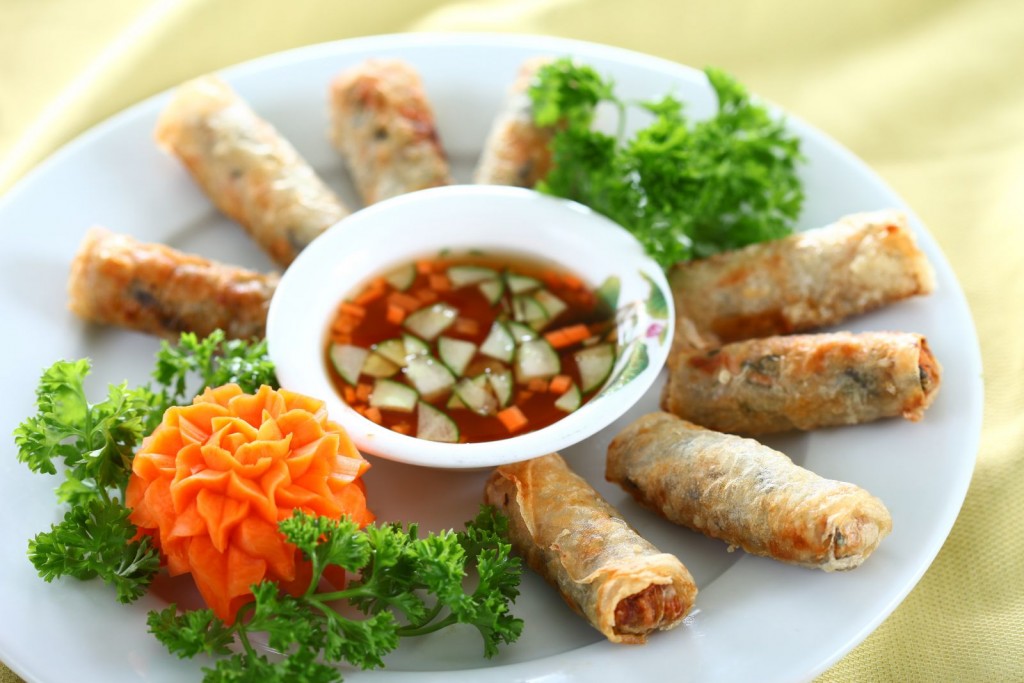
All ingredients are wrapped in rice paper and fried afterwards and are ready to be eaten hot and crispy.
Nem ran are delicious served with a sauce made of sugar, water, vinegar, pepper and chili spices
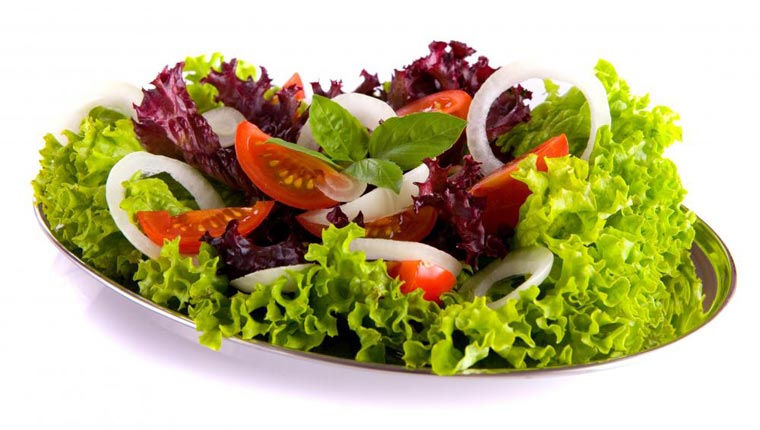
Gio Lua (Meat pie)
Pork pie is a dish that is popular with foreigners as well as Vietnamese. It consists of boiled minced pork wrapped in banana leaves. The tastiest part of the pate is the top layer because the meat absorbs the taste of the banana leaves.
This dish is not called the same in the North as in the South.
Banh Chung (Square sticky rice cake)
The glutinous rice cake, banh chung, is one of the most typical traditional Vietnamese dishes during Tet celebrations; every family prepares a dish and places it on the ancestor’s altar.
Banh chung is made of glutinous rice, pork and green beans. It is wrapped in a phrynium leaf which gives it its green colour.
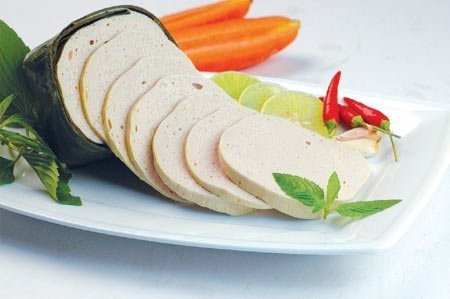
Vietnamese cuisine in general, and the traditional gastronomic culture of the Vietnamese in particular, is a tenacious, indestructible entity in the context of the Eastern culture. In fact, it is the fruit of a latent crossbreeding of many years with the culture of the region, commonly based on a thousand-year-old rural economy of rice cultivation under irrigation.
The character of Vietnamese cuisine is very varied and refined by the wide variety of ingredients and herbs, such as coriander or lemongrass, used in the dishes.
An com in Vietnamese means to have a main meal consisting of rice accompanied by several dishes.
Rice: The rice is put into boiling water. When there is no more water, it is left to simmer. An ordinary meal (also called a folk meal) consists of rice and food.
Dry food: Meat, fish, shrimp, soy cheese, stir-fried vegetables, salted vegetables…
Soups: Soup (meat, vegetables, ribs…), crab soup, fish soup…
Nom (chopped vegetable salad). It is made of very finely chopped green papaya, cucumber, carrot, boiled lean pork, seasoned with crushed peanuts, vinegar, sugar, garlic, chilli. The name thus has various tastes. It is used in everyday meals as well as in banquets.
In recent years, Vietnamese people have become accustomed to eating lunch at their workplaces. Popular restaurants are springing up everywhere, especially near public services.
The organisation of a meal: the meal is not only for eating but also for conversation…
There is no such thing as a Western-style meal: no starter, main course, dessert, etc., but a multitude of dishes offered at the same time on the same table for the richest, or a single dish (savoury, sweet, or both) in the thousands of small street restaurants where diners move from one restaurant to another according to their wishes
At family dinners, most dishes are prepared in advance and placed in the centre of the table.
Rice is an essential dish at meals in Vietnam
Rice or rice noodles form the basis of all Vietnamese dishes.
Fish, chicken and pork dishes, accompanied by cooked vegetables and steamed rice, make up the traditional meals. The dishes themselves are not usually spicy, however, you will always find a wide variety of condiments on your table including chilli sauce, soy sauce and the famous Nuoc Nam fish sauce.

